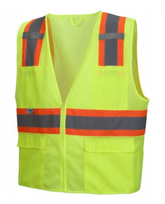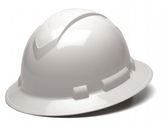Self-Retracting Lifelines vs. Fall Protection Lanyards

Working at height demands proper fall protection, which saves lives on construction sites every day. Self-retracting lifelines (SRLs) and lanyards are standard options; however, selecting the right one for your specific needs isn’t always straightforward. We’ll provide a comparison of self-retracting lifelines vs. fall protection lanyards so you can choose the best fall protection for your job site.
What is a Self-Retracting Lifeline (SRL)?
A self-retracting lifeline works like a giant tape measure attached to your safety harness. The device contains a spring-loaded drum that allows the lifeline to extend and retract automatically as you move around. When you walk closer to your anchor point, the lifeline retracts. When you move away, it extends to give you the freedom to work.
The real safety magic happens when you fall. Internal mechanisms detect the sudden acceleration and immediately lock the lifeline, stopping your fall within just a few feet. This quick response dramatically reduces the forces your body experiences during a fall arrest.
Types of SRLs
SRLs come in two main varieties:
- Cable SRLs: They’re incredibly durable and resist wear from sharp edges or rough surfaces. You’ll find these on job sites where the work environment might damage other materials.
- Web SRLs: They’re typically lighter and more flexible, making them comfortable for all-day wear. The webbing also won’t conduct electricity, making it safer around electrical work.
Advantages of Using SRLs
SRLs offer several benefits that make them popular on construction sites. They provide constant fall protection without restricting your movement. You can walk around freely within the device’s range without needing to adjust anything manually.
The short arrest distance is another significant advantage; OSHA standard is 2 feet. which means you’re less likely to hit lower levels or obstacles during a fall. This quick arrest also reduces the forces on your body and the anchor point. Many workers find SRLs more comfortable for extended use because there’s no slack in the line to get caught on things or create trip hazards.
What is a Fall Protection Lanyard?

A fall protection lanyard is a flexible line that connects your safety harness to an anchor point, providing a secure connection. Think of it as a tether that keeps you attached to a secure location while you work. Lanyards come in various lengths, typically ranging from 4 to 6 feet in length.
The most common type you’ll see on construction sites is the shock-absorbing lanyard. These contain special webbing or mechanisms designed to reduce the impact forces during a fall by stretching or tearing in a controlled manner.
How Lanyards Work in Fall Arrest
When you fall while wearing a lanyard, the device activates to slow your descent and distribute the stopping forces across your body. Shock-absorbing lanyards do this by allowing controlled deformation of the webbing or internal components.
The lanyard length, plus the shock absorption distance, determines your total fall distance, which can range from 6 to 12 feet, depending on the specific lanyard and your working position.
Advantages of Using Lanyards
Lanyards offer simplicity and reliability that many workers appreciate. They’re straightforward to use, inspect, and maintain. There are no moving parts to break or complex mechanisms to understand.
They’re also typically more affordable than SRLs, making them attractive for smaller crews or tighter budgets. Lanyards are well-suited for situations where you don’t require a lot of mobility or where anchor points are readily available near your work area.
The variety of lanyard types available means you can find options specifically designed for different work environments, from basic shock-absorbing models to specialized versions for positioning or restraint.
SRL vs. Lanyard: Key Differences

Understanding the key differences between SRLs and lanyards is essential for selecting the appropriate equipment for your specific needs. Making the correct choice ensures the highest level of safety for your team and helps maintain efficiency on the job.
Arresting Distance
This is often the most critical difference. SRLs typically arrest falls within 3.5 feet, while lanyards can allow fall distances of 6 to 12 feet. If you’re working close to lower levels, obstacles, or the ground, the shorter arrest distance of an SRL could prevent serious secondary injuries.
Mobility and Flexibility
SRLs win hands-down when it comes to mobility. The automatic extending and retracting action means you can move freely within the device’s range without constantly managing the slack line. Lanyards require more conscious management to avoid trip hazards and ensure proper positioning.
With a lanyard, you need to stay within its fixed length of your anchor point. This can limit where you can work and may require multiple anchor points for larger work areas.
Suitability for Different Work Environments
SRLs excel in situations where you need to move around frequently or work at varying distances from your anchor point. They’re ideal for roofing, steel erection, and other jobs requiring mobility.
Lanyards work better for stationary work or situations where you’re working close to your anchor point. They’re often the go-to choice for ladder work, scaffolding, or maintenance tasks in confined areas.
Factors to Consider When Choosing
When you’re deciding between an SRL and a lanyard, several factors should influence your choice. Let’s break down what you need to consider to make the right decision for your work environment.
Height of the Work Area
The height where you’re working affects which option makes sense. If you’re working close to the ground or lower levels, an SRL’s shorter arrest distance becomes crucial. For higher work areas with ample clearance below, either option may work.
Potential Fall Distance
Calculate the total fall distance for each option, including the equipment’s arrest distance, your body length, and any safety margin. Make sure there’s adequate clearance below your work area for the worst-case scenario.
Worker Mobility Requirements
Consider how much you need to move around during your work. Jobs that require constant movement favor SRLs, while stationary or limited-movement tasks may work well with lanyards.
Environmental Conditions
Think about the work environment. Electrical work might favor web-based equipment. Areas with sharp edges or abrasive surfaces may require more durable cable options.
Weather conditions matter too. Wind can affect larger SRLs more than compact lanyards. Cold temperatures can impact the performance of some shock-absorbing lanyards.
Make the Right Choice for Your Team’s Safety
Choosing between SRLs and fall protection lanyards comes down to matching the equipment to your specific work requirements. SRLs offer superior mobility and shorter arrest distances, making them ideal for jobs requiring movement and situations with limited clearance below. Lanyards provide reliable, cost-effective protection for more stationary work where mobility isn’t a primary concern.
Remember that the best fall protection equipment is the one your team will use correctly and consistently. Consider your work environment, mobility needs, budget constraints, and clearance requirements when making your decision.
Check out the comprehensive selection of fall protection equipment at Buyer’s Safety today. Our team of safety professionals brings over 30 years of experience in the construction industry to help you select the right equipment for your specific needs.








Leave a comment
All blog comments are checked prior to publishing